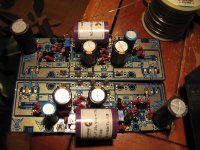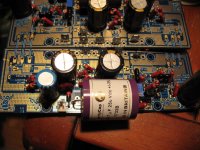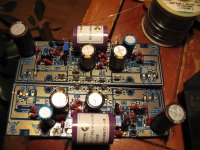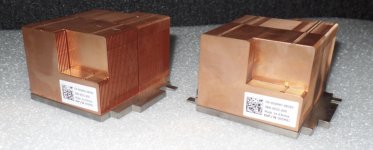To X or Huge
The C112 0.01uF can be only an FKP type? I don't have at home, I do have MKP type (polypropylene). To place an order for 2PC 50Cent value caps that is not me in my situation. Unfortunately, I miss that when I made my order and today at the stuffing the PC boards just realized it.
Please let me know.
Thank you
MKP box cap is fine there.
MKP box cap is fine there.
Thank you! I will use that.
This is my progress on this amp, see the pictures.
I still don't know which way I will take this project, to get a bit more power like 30W or so (not 50W) or keep it simple 20W.
I did mention my reason why I wish to have a bit more power, I have too many Class A 20W or close to 20W projects.
If I decide to get more watts I will have to etch 2 output PC boards for this and will use Toshiba power mosfets.
I have at least 25-30 pairs of those expensive mosfets laying around not used.
I will dismantle my Aleph X 120W class A amp. It consumes too much electricity, biassed at 24V 7A per channel, also I canceled the Aleph2 project, another 100W type. To replace those two I need one something at least 30-35W Class A project.
Greetings
Attachments
Hi Gaborbela,
Great progress and beautiful work. I have an idea for you - no need to make another daughter board for outputs. Just use flying leads to a pair (need to be matched though). Run circa +/-27v rails and 1.5amp to 1.7amp bias for about 40w to 45w dissipation each. That should give you close to 30-32w I think. Hugh can probably give you more specifics but seems you are determined to use multiple outputs so I think just try it. I agree that we do have plenty of 20w to 25w Class A designs around so good to try a higher power solution. Should be relatively safe in this configuration if you are using your massive heatsinks.
Good luck.
Great progress and beautiful work. I have an idea for you - no need to make another daughter board for outputs. Just use flying leads to a pair (need to be matched though). Run circa +/-27v rails and 1.5amp to 1.7amp bias for about 40w to 45w dissipation each. That should give you close to 30-32w I think. Hugh can probably give you more specifics but seems you are determined to use multiple outputs so I think just try it. I agree that we do have plenty of 20w to 25w Class A designs around so good to try a higher power solution. Should be relatively safe in this configuration if you are using your massive heatsinks.
Good luck.
Last edited:
There may be some system wide changes in DIYA as someone else complained of same thing. I don’t have my notifications turned on by default so doesn’t matter for me. We might try asking this in the Forum Problems thread. Looks like Jason is already looking into it...
Gaborela,
How can I help?
If you want more power, you are forced to:
1. Either move to the BB 52W, which consumes 400W of heat, or
2. Set up two voltage supplies for both channels. Positive, 24V, and negative, 28V.
#1 will give you unbelievable power from a SE.
#2 will increase the output power from 19W with 24V rails to 28W with 24P/28N rails.
What Toshiba output devices do you have?
Hugh
How can I help?
If you want more power, you are forced to:
1. Either move to the BB 52W, which consumes 400W of heat, or
2. Set up two voltage supplies for both channels. Positive, 24V, and negative, 28V.
#1 will give you unbelievable power from a SE.
#2 will increase the output power from 19W with 24V rails to 28W with 24P/28N rails.
What Toshiba output devices do you have?
Hugh
Gaborbela,
These Toshiba devices are OK. They are 120W/10A/180V/4S/1300pF which are easy for the design to drive. However, they do require considerably less Vgs to drive, which will improve the negative clip, giving about 25W from 24V rails.
The amplifier has no adjustments and no other figures need to be changed.
If you are able to easily match a pair of nmos and another pair of pmos in both Vgs at 1.5A and transconductance at the same current (difficult to measure), then you could use two pairs for more power, but you'd need more voltage rail, I would try 32V. Then you will be looking at 45W into 8R, which is 53.7Vpp into 8R. At this current, the quiescent should be increased to 1.7A FOR EACH PAIR, total 3.4A. Beware: these outputs will get hot, a total of 218W per channel!!
Cheers,
Hugh
These Toshiba devices are OK. They are 120W/10A/180V/4S/1300pF which are easy for the design to drive. However, they do require considerably less Vgs to drive, which will improve the negative clip, giving about 25W from 24V rails.
The amplifier has no adjustments and no other figures need to be changed.
If you are able to easily match a pair of nmos and another pair of pmos in both Vgs at 1.5A and transconductance at the same current (difficult to measure), then you could use two pairs for more power, but you'd need more voltage rail, I would try 32V. Then you will be looking at 45W into 8R, which is 53.7Vpp into 8R. At this current, the quiescent should be increased to 1.7A FOR EACH PAIR, total 3.4A. Beware: these outputs will get hot, a total of 218W per channel!!
Cheers,
Hugh
Beware: these outputs will get hot, a total of 218W per channel!!
That's 55w per MOSFET and kind of on the high side for a safe long term operation unless one had very good heat removal (like a heat pipe spreader). At lease use ceramic insulator pads with good heatsink compound.
If anyone need any aluminum cpu heat sinks I have a lot of them and maybe some copper ones as well. I save them from scrapping PCs. After I get back from my sons wedding in a week I will round them up and take some photos. That is if this will help you guys with any cooling problems that you need to work out
Thanks for the offer. CPU heatsinks with a small PWM fan can handle Class A loads up to 120w no problem. That’s what I use on my Alpha BB and on Aksa’s Omega Class A. For Class AB, I am using the smaller silver aluminum Dell FW’s and they really can’t work without at least some airflow as fin spacing is very tight.
Just completed another developmental project with Hugh and JPS64. It's off topic but thought folks in this thread would be interested.
It's a 60-80wrms (depends on rails) Class AB that has a very nice harmonic profile and is super quiet. Having BJT outputs, runs at a low quiescent current so very cool running yet manages some mind blowing bass authority with gobs of dynamic headroom. It's a commercial design so I am not at liberty to say too much about it technically other than it is a singleton input and uses a clever VAS stage, but typical 2SA1837/2SC4793 drivers and 2SA1943/2SC5200 outputs. I have chosen to make the proto in true monoblock with integrated PSU with underhung monlithic bridges and 8x4700uF caps per channel. The integrated PSU is very nice in that it keeps the amp case floor free to install dual trafos which would normally never fit in an amp case this small. Secondly, the local placement of the PSU gives incredibly low impedance for the high currents to give great bass authority. Being totally independent dual monoblocks (only common connection is star ground above the GLB), the amp is super quiet. I measure 0.0mV rms on the Fluke 101 at the outputs with DAC source still connected but turned to zero volume. The ultra-low noise performance is a function of several factors: the singleton front end (2N5401), JPS64's super layout with excellent ground paths and well thought out location of terminals and input/output jacks, careful attention to overall integration and use of ground loop breaker (NTC thermistor) and star ground topology, use of dual toroidal trafos, and use of RG-174 coax for all signal connections from RCA to vol pot and back to amp PCB.
Here are some photos of the build:
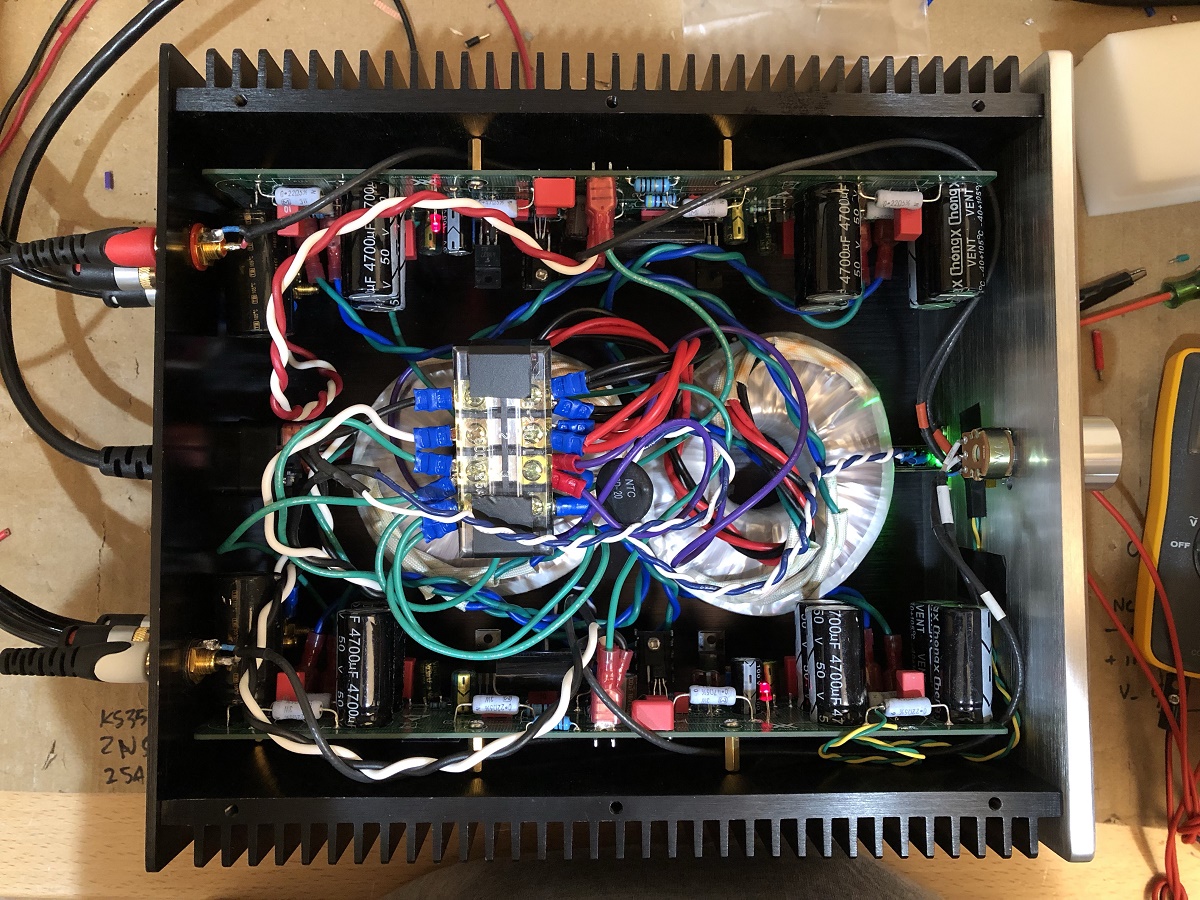
Low noise measurement at output:
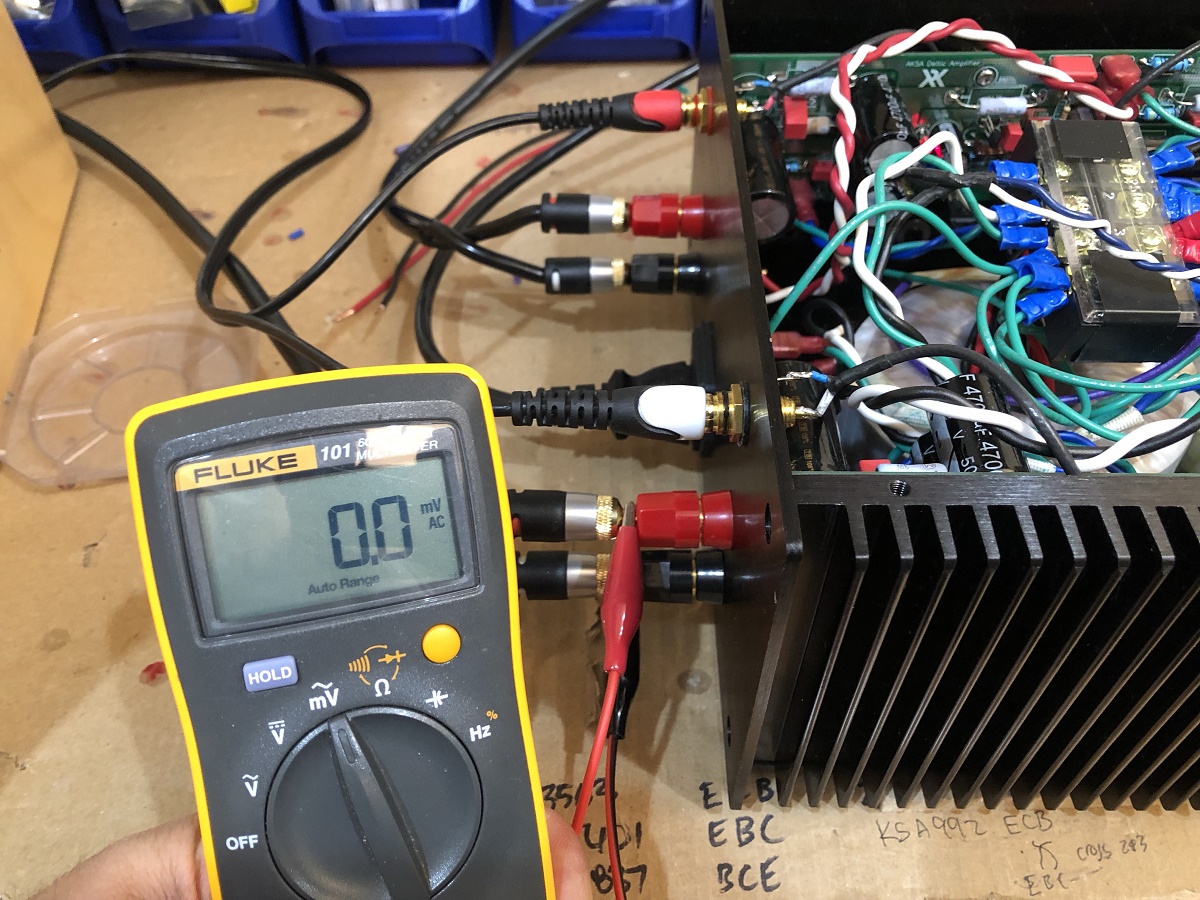
Back panel:
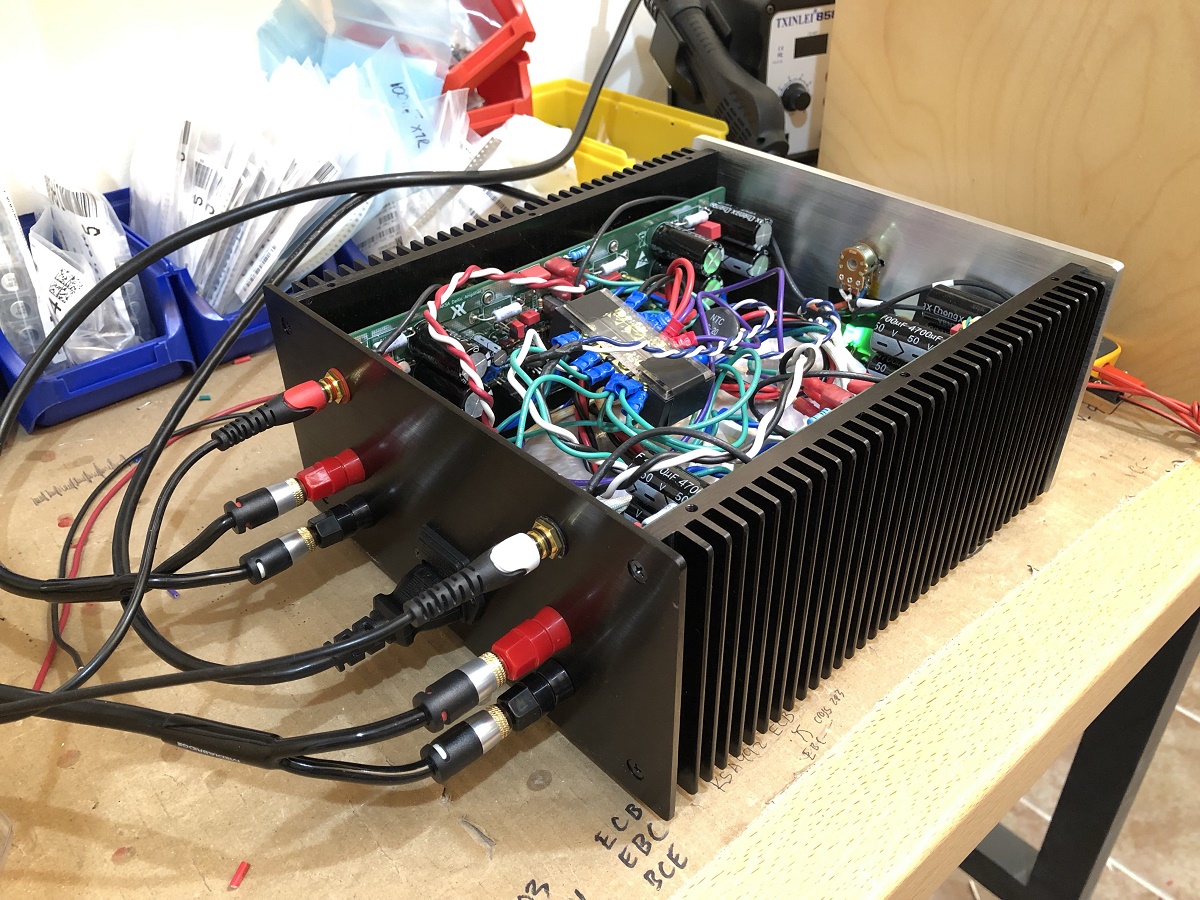
front panel:
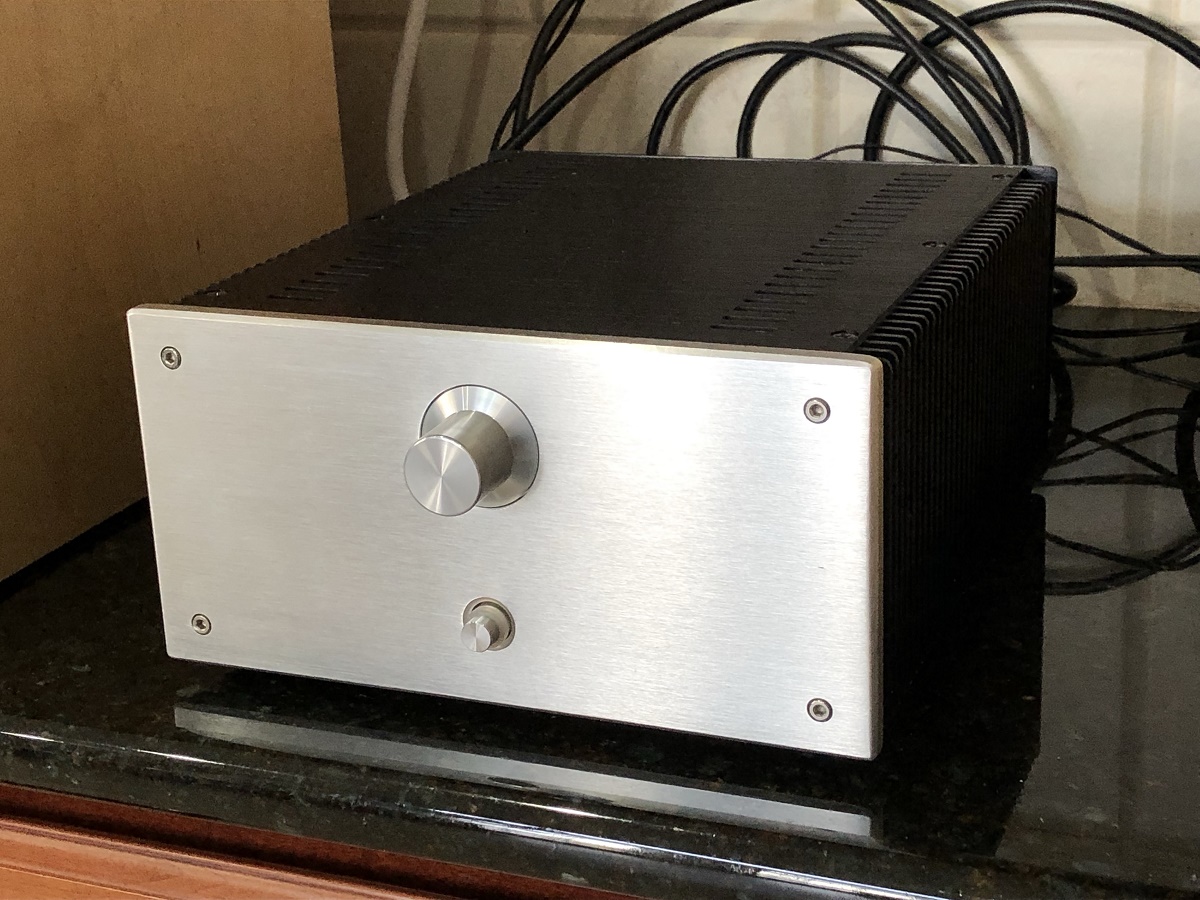
Here is FFT for 2.90vrms into 8ohms showing about 0.033%THD and nice descending profile:
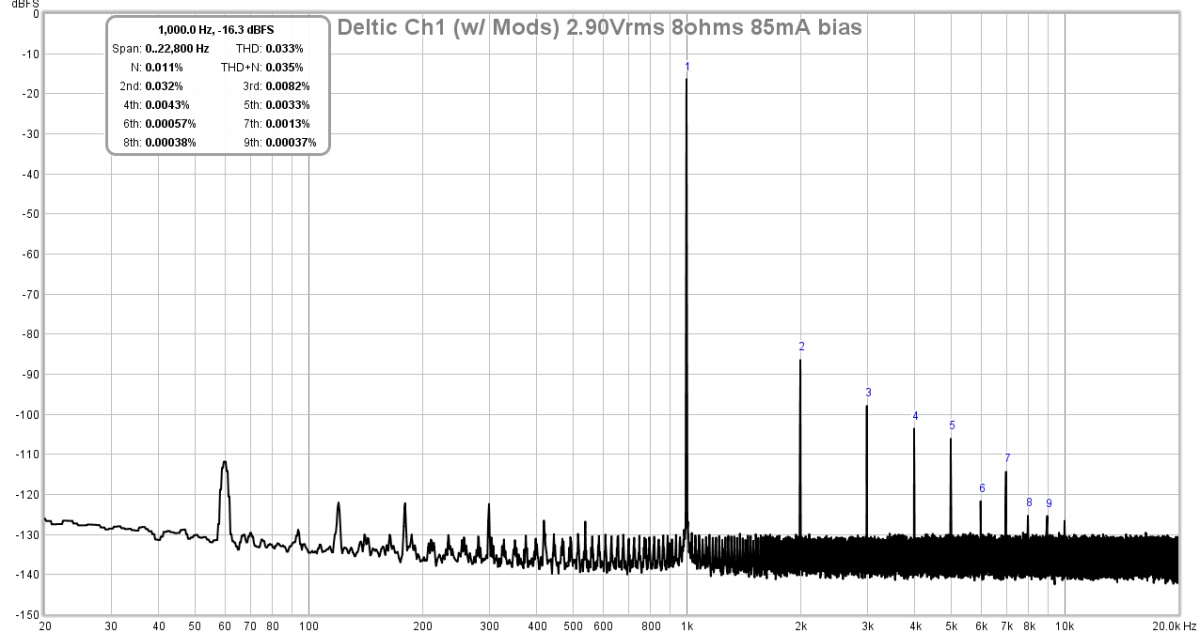
Here is 22.8Vpp into 8ohms or about 8wrms FFT, with same harmonic profile - so sound is very consistent at low or higher power:
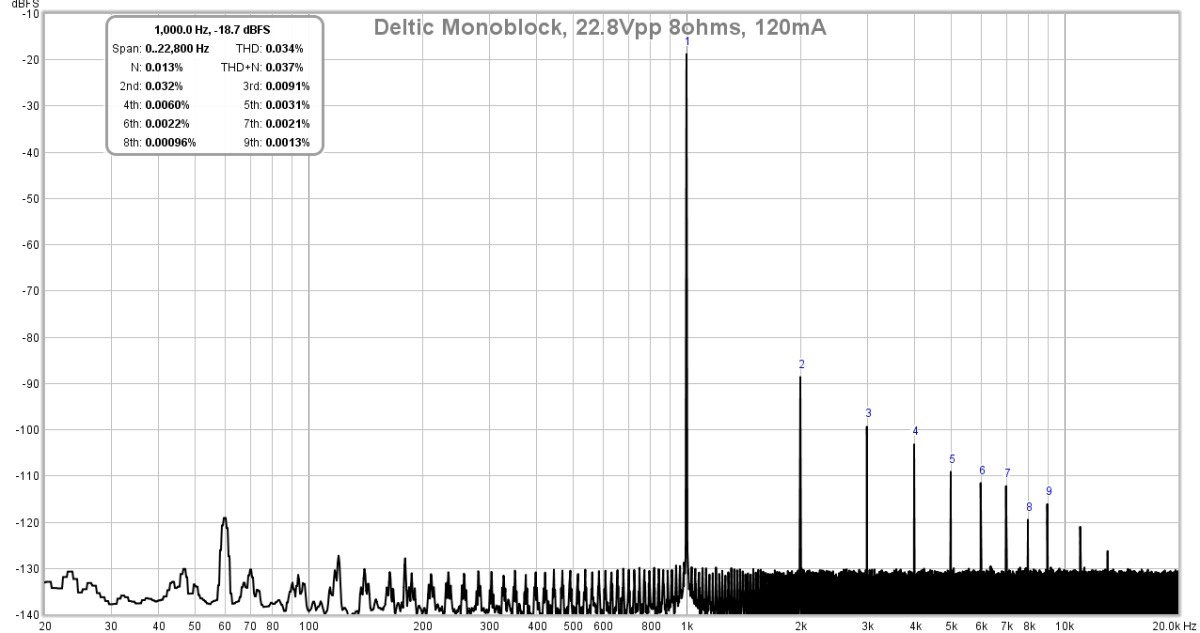
Here is an o-scope 1khz sine into 8ohms before clipping showing 63.8Vpp:
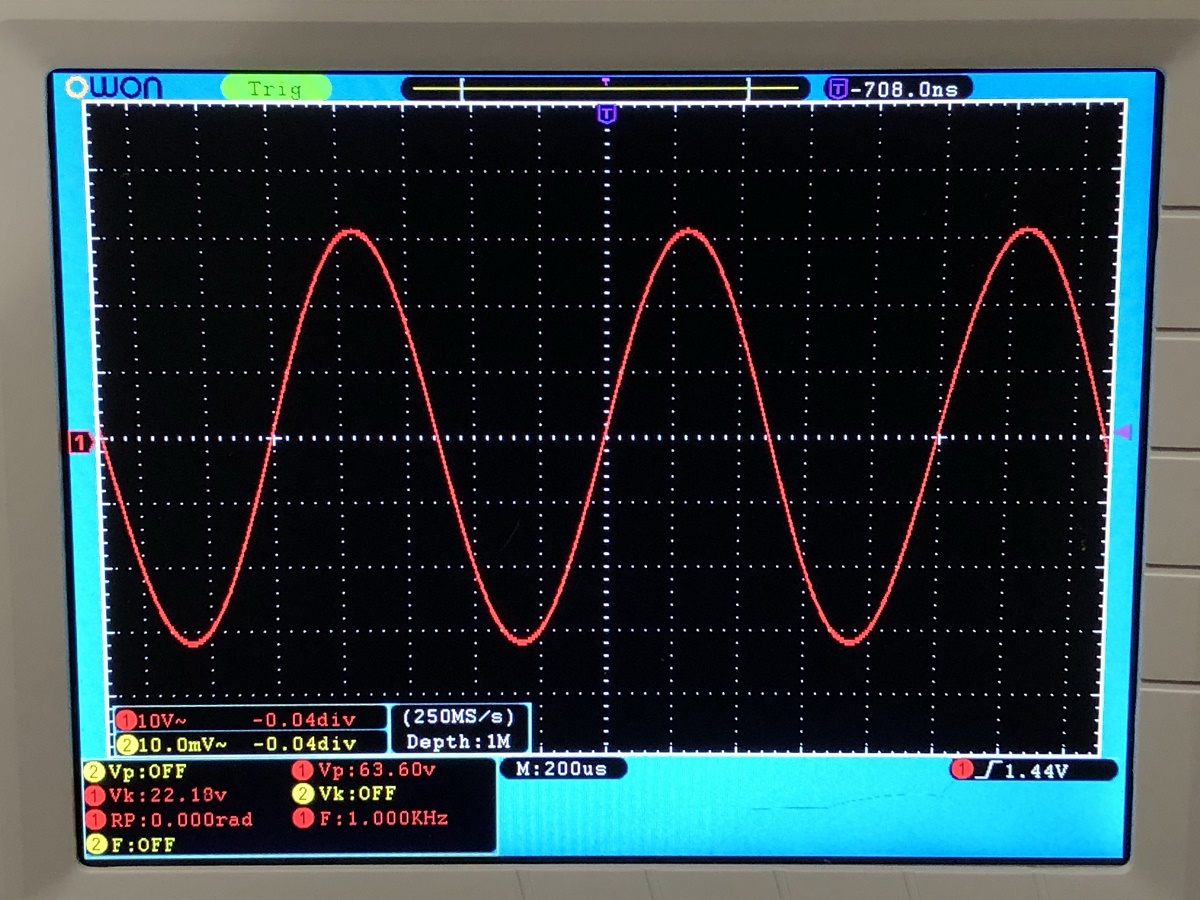
Here is a 10kHz square wave with about 700ns (1/e) risetime:
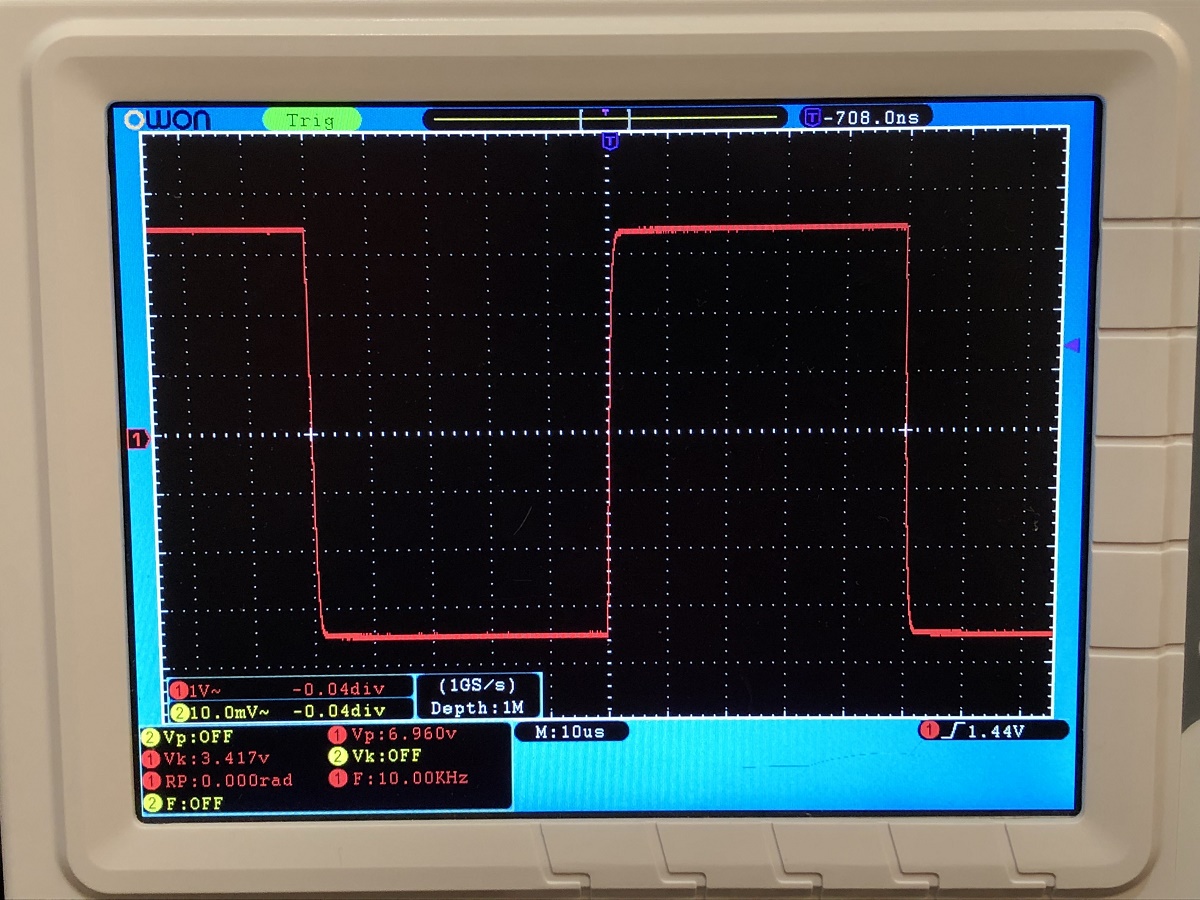
Here it is with my 10F/RS225 reference FAST speakers. I have listened to it for almost a week now and it is a very nice amp. Can't believe how cool it runs.
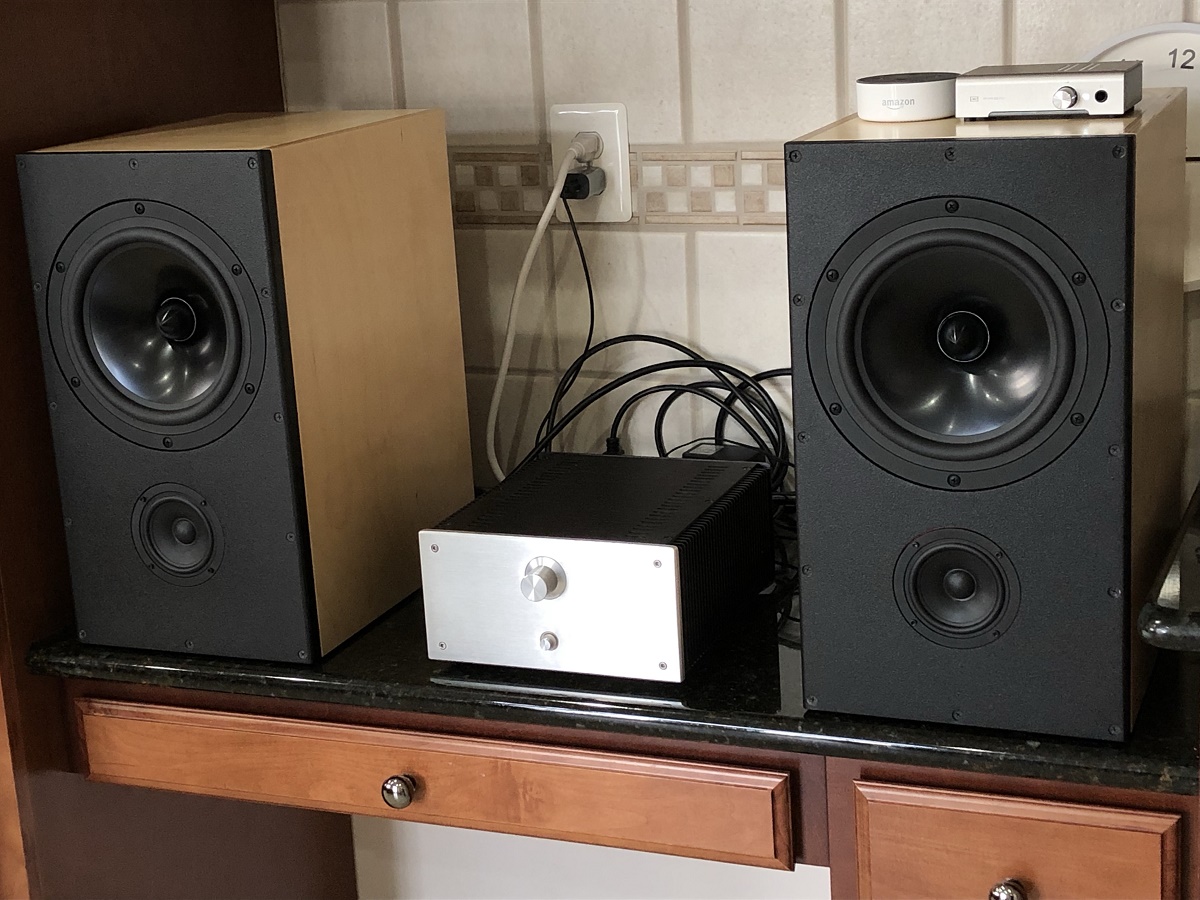
Listening impressions are on-going, but most noticeable is a pleasant easy presentation that is engaging and draws you in. Visceral super double impact bass well beyond its power rating would ever imply. I have not measured the DF, but would assume it is some big number. Imaging and sound stage, as you would expect with isolated monoblocks, is superb. I can turn up the volume and it plays clean even when very loud.
It's a 60-80wrms (depends on rails) Class AB that has a very nice harmonic profile and is super quiet. Having BJT outputs, runs at a low quiescent current so very cool running yet manages some mind blowing bass authority with gobs of dynamic headroom. It's a commercial design so I am not at liberty to say too much about it technically other than it is a singleton input and uses a clever VAS stage, but typical 2SA1837/2SC4793 drivers and 2SA1943/2SC5200 outputs. I have chosen to make the proto in true monoblock with integrated PSU with underhung monlithic bridges and 8x4700uF caps per channel. The integrated PSU is very nice in that it keeps the amp case floor free to install dual trafos which would normally never fit in an amp case this small. Secondly, the local placement of the PSU gives incredibly low impedance for the high currents to give great bass authority. Being totally independent dual monoblocks (only common connection is star ground above the GLB), the amp is super quiet. I measure 0.0mV rms on the Fluke 101 at the outputs with DAC source still connected but turned to zero volume. The ultra-low noise performance is a function of several factors: the singleton front end (2N5401), JPS64's super layout with excellent ground paths and well thought out location of terminals and input/output jacks, careful attention to overall integration and use of ground loop breaker (NTC thermistor) and star ground topology, use of dual toroidal trafos, and use of RG-174 coax for all signal connections from RCA to vol pot and back to amp PCB.
Here are some photos of the build:
Low noise measurement at output:
Back panel:
front panel:
Here is FFT for 2.90vrms into 8ohms showing about 0.033%THD and nice descending profile:
Here is 22.8Vpp into 8ohms or about 8wrms FFT, with same harmonic profile - so sound is very consistent at low or higher power:
Here is an o-scope 1khz sine into 8ohms before clipping showing 63.8Vpp:
Here is a 10kHz square wave with about 700ns (1/e) risetime:
Here it is with my 10F/RS225 reference FAST speakers. I have listened to it for almost a week now and it is a very nice amp. Can't believe how cool it runs.
Listening impressions are on-going, but most noticeable is a pleasant easy presentation that is engaging and draws you in. Visceral super double impact bass well beyond its power rating would ever imply. I have not measured the DF, but would assume it is some big number. Imaging and sound stage, as you would expect with isolated monoblocks, is superb. I can turn up the volume and it plays clean even when very loud.
Attachments
-
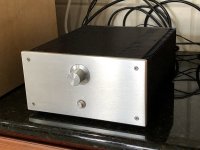 Deltic-cased-05.jpg356.1 KB · Views: 1,618
Deltic-cased-05.jpg356.1 KB · Views: 1,618 -
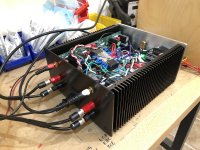 Deltic-cased-03.jpg461.2 KB · Views: 3,601
Deltic-cased-03.jpg461.2 KB · Views: 3,601 -
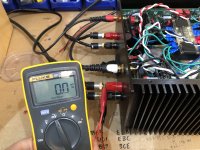 Deltic-cased-02.jpg423.3 KB · Views: 600
Deltic-cased-02.jpg423.3 KB · Views: 600 -
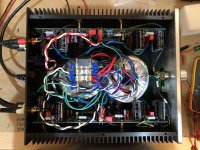 Deltic-cased-01.jpg506.8 KB · Views: 2,596
Deltic-cased-01.jpg506.8 KB · Views: 2,596 -
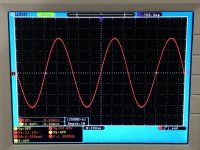 Deltic-cased-05-sine.jpg366.4 KB · Views: 589
Deltic-cased-05-sine.jpg366.4 KB · Views: 589 -
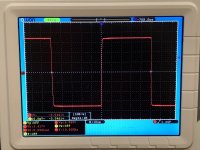 Deltic-cased-05-square.jpg345.9 KB · Views: 591
Deltic-cased-05-square.jpg345.9 KB · Views: 591 -
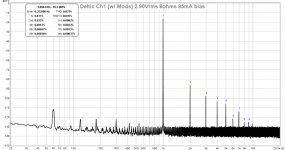 Deltic-FFT-2.90Vpp-FFT.jpg137 KB · Views: 924
Deltic-FFT-2.90Vpp-FFT.jpg137 KB · Views: 924 -
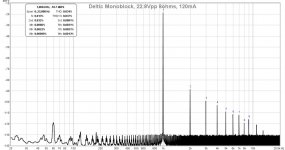 Deltic-FFT-22.8Vpp-FFT.jpg129.5 KB · Views: 912
Deltic-FFT-22.8Vpp-FFT.jpg129.5 KB · Views: 912 -
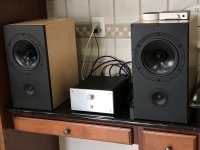 Deltic-cased-04.jpg337.8 KB · Views: 2,600
Deltic-cased-04.jpg337.8 KB · Views: 2,600
Last edited:
To play a orchestral music or, more complicated, orchestral with voices like Opera, I agree with Nelson Pass:
https://www.diyaudio.com/forums/pas...-complicated-symphonic-music.html#post5604051
This evening I have listen a very good recording with high dynamic, DR15. 1972 -> analogue master, my favourite!
Verdi - Cristina Deutekom, Placido Domingo, Ruggero Raimondi & Lamberto Gardelli, The Royal Philharmonic Orchestra, The Ambrosian Singers – I Lombardi (1972), Vinyl x3, Philips, Netherlands
https://www.diyaudio.com/forums/pas...-complicated-symphonic-music.html#post5604051
But, too much clean, without H2 predominance -> anechoic sound, without life/soul/EMOTION.When the music gets complicated and/or dynamic, there is more tendency to favor the amplifiers with lower measured distortion.
I think this is because the intermodulation distortion that accompanies complex material is a aggravated by even low orders of harmonic distortion.
This evening I have listen a very good recording with high dynamic, DR15. 1972 -> analogue master, my favourite!
Verdi - Cristina Deutekom, Placido Domingo, Ruggero Raimondi & Lamberto Gardelli, The Royal Philharmonic Orchestra, The Ambrosian Singers – I Lombardi (1972), Vinyl x3, Philips, Netherlands
Last edited:
You do not have permission to view the video in your country (Spain).
I have a lot of Opera, the best recordings with the best interpretations. Modern records -from digital masters- sound very well, spectacular but they do not excite me.
It is incredible that a small 5.5" coaxial speaker can play Opera and orchestral. Well, part of the merit is due to my gadgets to clean the noise/DC/ripple from my terrible electrical grip. I suspect that they also lower the input impedance and hence the bass is more powerful, so much so that sometimes there seems to be a subwoofer! I know, it is hard to believe but it is true.
I have a lot of Opera, the best recordings with the best interpretations. Modern records -from digital masters- sound very well, spectacular but they do not excite me.
It is incredible that a small 5.5" coaxial speaker can play Opera and orchestral. Well, part of the merit is due to my gadgets to clean the noise/DC/ripple from my terrible electrical grip. I suspect that they also lower the input impedance and hence the bass is more powerful, so much so that sometimes there seems to be a subwoofer! I know, it is hard to believe but it is true.
- Home
- Amplifiers
- Solid State
- Aksa Lender P-MOS Hybrid Aleph (ALPHA) Amplifier
